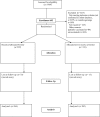Long-term protection against HBV chronic carriage of Gambian adolescents vaccinated in infancy and immune response in HBV booster trial in adolescence
- PMID: 17710152
- PMCID: PMC1940311
- DOI: 10.1371/journal.pone.0000753
Long-term protection against HBV chronic carriage of Gambian adolescents vaccinated in infancy and immune response in HBV booster trial in adolescence
Abstract
Background: Chronic infection with hepatitis B virus (HBV) arising in childhood is associated with hepatocellular carcinoma in adult life. Between 1986 and 1990, approximately 120,000 Gambian newborns were enrolled in a randomised controlled trial to assess the effectiveness of infant HBV vaccination on the prevention of hepatocellular carcinoma in adulthood. These children are now in adolescence and approaching adulthood, when the onset of sexual activity may challenge their hepatitis B immunity. Thus a booster dose in adolescence could be important to maintain long-term protection.
Methods: Fifteen years after the start of the HBV infant vaccination study, 492 vaccinated and 424 unvaccinated children were identified to determine vaccine efficacy against infection and carriage in adolescence. At the same time, 297 of the 492 infant-vaccinated subjects were randomly offered a booster dose of HBV vaccine. Anti-HBs was measured before the booster, and two weeks and 1 year afterwards (ISRCTN71271385).
Results: Vaccine efficacy 15 years after vaccination was 67.0% against infection as manifest by anti-HBc positivity (95% CI 58.2-74.6%), and 96.6% against HBsAg carriage (95% CI 91.5-100%). 31.2% of participants had detectable anti-HBs with a GMC of 32 IU/l. For 168 boosted participants GMC anti-HBs responses were 38 IU/l prior to vaccination, 524 IU/l two weeks after boosting, and 101 IU/l after 1 year.
Conclusions: HBV vaccination in infants confers very good protection against carriage up to 15 years of age, although a large proportion of vaccinated subjects did not have detectable anti-HBs at this age. The response to boosting persisted for at least a year.
Trial registration: Controlled-Trials.com ISRCTN71271385.
Conflict of interest statement
References
-
- Lavanchy D. Worldwide epidemiology of HBV infection, disease burden, and vaccine prevention. J Clin Virol. 2005;34:S1–S3. - PubMed
-
- The Gambia Hepatitis Study Group. The Gambia Hepatitis Intervention Study. Cancer Research. 1987;47:5782–5787. - PubMed
-
- Viviani S, Jack A, Hall AJ, Maine N, Mendy M, et al. Hepatitis B vaccination in infancy in The Gambia: protection against carriage at 9 years of age. Vaccine. 1999;17:2946–2950. - PubMed
-
- Bulkow LR, Wainwright RB, McMahon BJ, Parkinson AJ. Increases in levels of antibody to hepatitis B surface antigen in an immunized population. Clin Infect Dis. 1998;26:933–937. - PubMed
-
- Coursaget P, Leboulleux D, Soumare M, Cann PL, Yvonnet B, et al. Twelve-year follow-up study of hepatitis B immunization of Senegalese infants. J Hepatol. 1994;21:20–24. - PubMed
Publication types
MeSH terms
Substances
Grants and funding
LinkOut - more resources
Full Text Sources
Medical


